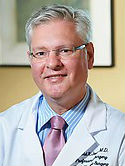Determinants of radiation exposure during mobile cone-beam CT-guided robotic-assisted bronchoscopy Journal Article
| Authors: | Kalchiem-Dekel, O.; Bergemann, R.; Ma, X.; Christos, P. J.; Miodownik, D.; Gao, Y.; Mahmood, U.; Adusumilli, P. S.; Bott, M. J.; Dycoco, J.; Gelblum, D. Y.; Lee, R. P.; Park, B. J.; Rocco, G.; Solomon, S. B.; Jones, D. R.; Chawla, M.; Husta, B. C. |
| Article Title: | Determinants of radiation exposure during mobile cone-beam CT-guided robotic-assisted bronchoscopy |
| Abstract: | Background and Objective: Robotic-assisted bronchoscopy (RAB) is an emerging modality to sample pulmonary lesions. Cone-beam computed tomography (CBCT) can be incorporated into RAB. We investigated the magnitude and predictors of patient and staff radiation exposure during mobile CBCT-guided shape-sensing RAB. Methods: Patient radiation dose was estimated by cumulative dose area product (cDAP) and cumulative reference air kerma (cRAK). Staff equivalent dose was calculated based on isokerma maps and a phantom simulation. Patient, lesion and procedure-related factors associated with higher radiation doses were identified by logistic regression models. Results: A total of 198 RAB cases were included in the analysis. The median patient cDAP and cRAK were 10.86 Gy cm2 (IQR: 4.62-20.84) and 76.20 mGy (IQR: 38.96-148.38), respectively. Among staff members, the bronchoscopist was exposed to the highest median equivalent dose of 1.48 mu Sv (IQR: 0.85-2.69). Both patient and staff radiation doses increased with the number of CBCT spins and targeted lesions (p < 0.001 for all comparisons). Patient obesity, negative bronchus sign, lesion size <2.0 cm and inadequate sampling by on-site evaluation were associated with a higher patient dose, while patient obesity and inadequate sampling by on-site evaluation were associated with a higher bronchoscopist equivalent dose. Conclusion: The magnitude of patient and staff radiation exposure during CBCT-RAB is aligned with safety thresholds recommended by regulatory authorities. Factors associated with a higher radiation exposure during CBCT-RAB can be identified pre-operatively and solicit procedural optimization by reinforcing radiation protective measures. Future studies are needed to confirm these findings across multiple institutions and practices. |
| Keywords: | radiation; skin; radiology; bronchoscopy; cone-beam computed tomography; staff; exposure; air kerma; transthoracic needle-biopsy; pulmonary nodule; lung nodules; dose-area product |
| Journal Title: | Respirology |
| Volume: | 29 |
| Issue: | 9 |
| ISSN: | 1323-7799 |
| Publisher: | Wiley Blackwell |
| Date Published: | 2024-09-01 |
| Start Page: | 803 |
| End Page: | 814 |
| Language: | English |
| ACCESSION: | WOS:001233653400001 |
| DOI: | 10.1111/resp.14765 |
| PROVIDER: | wos |
| PMCID: | PMC11329349 |
| PUBMED: | 38806394 |
| Notes: | Article -- MSK Cancer Center Support Grant (P30 CA008748) acknowledged in PubMed and PDF -- MSK corresponding author is Or Kalchiem-Dekel -- Source: Wos |
Altmetric
Citation Impact
BMJ Impact Analytics
MSK Authors
Related MSK Work

















